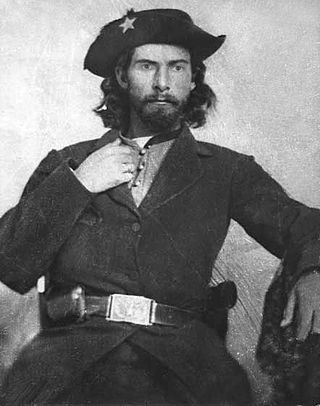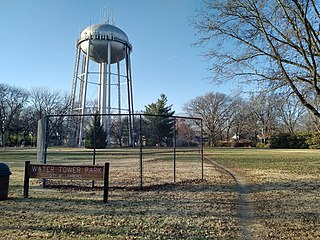
Morris County is a county located in the U.S. state of Kansas. As of the 2020 census, the county population was 5,386. The largest city and county seat is Council Grove.

Marion County is a county located in the U.S. state of Kansas. Its county seat is Marion and its most populous city is Hillsboro. As of the 2020 census, the county population was 12,660. The county was named in honor of Francis Marion, a brigadier general of the American Revolutionary War, known as the "Swamp Fox".

Council Grove is a city and county seat in Morris County, Kansas, United States. As of the 2020 census, the population of the city was 2,140. It was named after an agreement between American settlers and the Osage Nation allowing settlers' wagon trains to pass westward through the area on the Santa Fe Trail. Pioneers gathered at a grove of trees so that wagons could band together for their trip west.

William T. Anderson, known by the nickname "Bloody Bill" Anderson, was a soldier who was one of the deadliest and most notorious Confederate guerrilla leaders in the American Civil War. Anderson led a band of volunteer partisan raiders who targeted Union loyalists and federal soldiers in the states of Missouri and Kansas.

Colonel Cyrus Kurtz Holliday was an American railroad executive who was one of the founders of the township of Topeka, Kansas in the mid 19th century; and was Adjutant General of Kansas during the American Civil War. The title Colonel, however, was honorary. He was the first president of the Atchison, Topeka and Santa Fe Railway, as well as one of the railroad's directors for nearly 40 years, up to 1900. A number of railway locomotives have been named after him, as well as the former town of Holliday, Kansas. He was also the Deputy Grand Master of the Grand Lodge A.F. & A.M. of Kansas. As a Freemason, he was a member of Topeka Lodge #17 and was highly influential in the decision of moving the State Capitol to the city of Topeka.
Fort Zarah was a fort in Barton County, Kansas, northeast of present-day Great Bend, Kansas, that was used from 1864 to 1869.
The timeline of Kansas details past events that happened in what is present day Kansas. Located on the eastern edge of the Great Plains, the U.S. state of Kansas was the home of sedentary agrarian and hunter-gatherer Native American societies, many of whom hunted American bison. The region first appears in western history in the 16th century at the time of the Spanish conquest of the Aztec Empire, when Spanish conquistadors explored the unknown land now known as Kansas. It was later explored by French fur trappers who traded with the Native Americans. It became part of the United States in the Louisiana Purchase of 1803. In the 19th century, the first American explorers designated the area as the "Great American Desert."

The Kansas Museum of History is the state historical museum in Topeka, Kansas, United States. It presents Kansas history from the prehistoric to modern eras in 30,000 square feet (2,800 m2) of exhibits. The galleries feature a train, full-sized tipi in the Southern Cheyenne style, a 1950s diner, and many other large features. Major topics covered in the main gallery include Native American tribal history, westward movement on the Oregon and Santa Fe trails, early settlers, the Bleeding Kansas and Civil War eras, and Populism at the turn of the 20th century.
Kansas has always been home to many forts and military posts.
On March 7, 1862, Confederate guerrillas under William C. Quantrill raided the small Kansas community of Aubry, southwest of Kansas City, Missouri, and just west of the Kansas-Missouri border. Three residents were killed in the raid and much property was carted away by the guerrillas.

Lawrence, Kansas was not well defended in the early part of the Civil War. That ended with William Quantrill's devastating guerrilla raid August 21, 1863. By early 1864 Union soldiers were permanently camped on the top and slopes of Mount Oread, then to Lawrence's southwest. It seems the camp was originally named Camp Ewing, after Brig. Gen. Thomas Ewing.
Fort Aubrey, in eastern Hamilton County, Kansas, was established by the US Army in the 1850s. It originally had no name and was not made a truly permanent post until 1865. It was originally established to serve as a temporary resting place for traveling troops. The location of the fort is based upon a recommendation by François Xavier Aubry, for whom the fort is named.
During the Civil War, Coldwater Grove existed 131⁄2 miles east of Paola, Kansas, in Miami County. It straddled the Kansas-Missouri border, being partly in both states. About June 1863 a Union military post was established on the Kansas side of the community and the post was put under the command of Lt. Col. Charles S. Clark. Clark also commanded four nearby posts.
Fort Lincoln was established about August 24, 1861, by United States Senator James Lane. Earlier in August, Lane had reestablished Fort Scott as a military post. Soon Confederate troops under Maj. Gen. Sterling Price threatened to overrun the newly reopened post.
Fort McKean is a fort located inside Kansas along the Kansas-Missouri border. On November 14, 1862, Company C of the 3rd Wisconsin Cavalry, led by Lieut. James B. Pond, established a camp at Morris Mills on Drywood Creek. It was fifteen miles southeast of Fort Scott. Sometime later this camp was given the name of Fort McKean. The post was probably on the Fort Scott-Fort Gibson Military Road, and many, including Pond, thought the post was inside Missouri. Throughout its history, Fort McKean was a small post, ranging in strength from 20 to 60 men. It is unknown what buildings or defenses were erected there.
Fort Simple was an American fort built in Topeka, Kansas, as a result of Maj. Gen. Sterling Price's Missouri Raid in the late summer and fall of 1864. Topeka had become the permanent capital of the State of Kansas in 1861, but no fortifications had been built to protect the city from guerrilla bands, which roamed eastern Kansas. Even the raid and massacre in August 1863 in Lawrence, Kansas, did not result in a fort being built to protect the capital, although plans had been made to build one by July 1864.
The Lawrence blockhouses were a series of blockhouses built in the spring of 1864 in Lawrence, Kansas, to provide defensive structures in case of attack by Confederate guerrillas. On August 21, 1863, Lawrence had been attacked by 400 guerrillas and Confederate Army recruits under the command of William C. Quantrill. Lawrence was caught virtually defenseless and much of the town was destroyed and about 180 men and boys were killed, most of them defenseless. A militia became active by spring 1864 to prevent another attack.
Paola's post, sometimes called Post Paola, in Miami County, Kansas, was located on the west side of Bull Creek, just west of Paola, Kansas. It was probably established in December 1861, as that was the first time it was mentioned. This post became one of the more important posts along the Kansas-Missouri border during the Civil War. It became a district headquarters in 1863. Later, in September 1864, it was designated a subdistrict headquarters, when the district headquarters was moved to Lawrence, Kansas. The military road from Fort Leavenworth to Fort Gibson ran through Paola, thus ensuring the post always had some importance.
Fort Atkinson, 2 miles (3.2 km) west of Dodge City, had two lives. One life occurred before Kansas became a territory in 1854. The original Fort Atkinson was established August 8, 1850, by the U.S. Army in an attempt to prevent Indians in the area from attacking travelers on the Santa Fe Trail. Even before this, a site nearby was occupied in July 1850 by Lieut. Col. Edwin Vose Sumner, Who served as a Union major general in the Civil War. This first site was called Camp Mackay or Fort Mackay. Later the camp was moved to the site where it was permanently established. Sod buildings with canvas roofs were constructed. This post was abandoned in September 1853 and the buildings were torn down so Indians could not hide inside them and surprise travelers on the Trail.
Newell W. Spicer was a Union Army lieutenant colonel of volunteers during the American Civil War and a commander of the 1st Regiment Kansas Volunteer Infantry. He was also a leader of pro-abolitionist forces during Bleeding Kansas, a violent period in the history of Kansas when factions fought over proposals to abolish slavery in that state.






